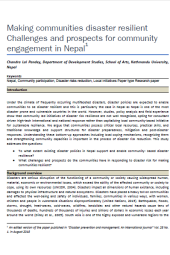Making Communities Disaster Resilient Challenges and Prospects for Community Engagement in Nepal
Summary
The paper entitled Making Communities Disaster-Resilient Challenges and Prospects for community engagement in Nepal was authored by Chandra Lal Pandey. This paper discusses the community-based disaster management system and describes it as the important pillar of disaster risk reduction and disaster management. Community-Based Disaster Risk Management (CBDRM) plays a vital role in enhancing community resilience and reducing the impact of hazards and disasters. The core principle of CBDRM is to empower communities to handle risks, minimize losses, and respond effectively during and after disasters until formal support arrives. It emphasizes community engagement, allowing local people to understand and prepare for hazards and risks specific to their area. CBDRM encourages collaboration and ownership, resulting in inclusive decision-making and problem-solving.
While community-led initiatives have been historically practiced in Nepal, there is a need for broader national implementation. The government, along with relevant policies and acts, should focus on effectively utilizing community resources through capacity-building programs. This includes providing disaster-related training and drills, establishing local disaster risk reduction teams, disseminating information, and engaging community members in preparedness and response efforts across the country. Such initiatives are crucial for immediate response and effective management of multiple hazards and disasters.
Categories:
Research Paper
Writer:
Chandra Lal Pandey
Publisher:
Disaster prevention and management: An international journal
Published Year:
2018
